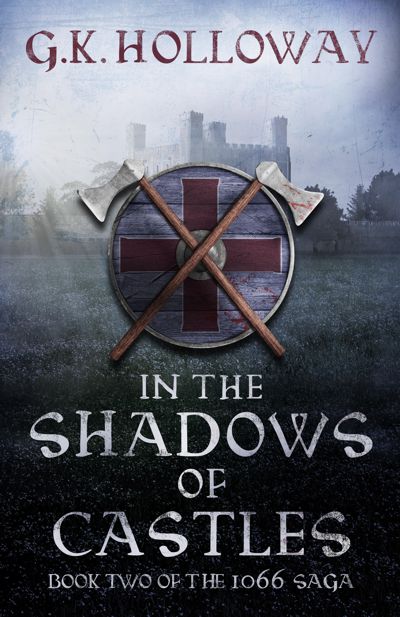
It’s the 1060s, and William of Normandy is establishing a new and brutal regime in England, but there are those who would defy him. As Norman soldiers spread like a plague across the land, resistance builds, but will it be enough to topple William and restore the rightful king to his throne? The English have the courage to fight, but the Normans, already victorious at Hastings, now build castles seeking to secure their tenuous foothold in these lands.
And what of the people caught up in these catastrophic events? Dispossessed but not defeated, their lives ripped apart, the English struggle for freedom from tyranny; amongst them, caught up in the turmoil, are a soldier, a thane and two sisters. As events unfold, their destinies become intertwined, bringing drastic changes that alter their lives forever.
Firmly embedded in the history of the Conquest, ‘In the Shadows of Castles’ is ultimately a story of love, hope, and survival in a time of war.
Author’s Inspiration
In the years immediately following the Norman Conquest, England was in turmoil. At the beginning of 1067, the William the Conqueror had only a tenuous hold on the southeast of the kingdom but felt confident enough, in March, to return to his dukedom as a hero. His glorious victory was celebrated the length and breadth of Normandy and for a while it looked as though England had fallen to him after a brief campaign of just ten weeks. But there was trouble in store for the new king.

In the interim, after the Battle of Hastings and before William’s coronation, the English had proclaimed Edgar Atheling as their new king. Many saw Edgar as the true king and he became a rallying point for rebels, and in the years immediately following the Conquest, a resistance to the Normans formed. There were battles from north to south and east to west and it took many years and extreme measures before William eventually secured his crown.
So, why should I write a novel about the fall of Anglo Saxon England? Well, the inspiration for my novel, 1066: What Fates Impose, came from reading a biography of Harold Godwinson, that my wife bought me. I found the book really opened my eyes to the late Anglo Saxon era. Once I’d finished it, I wanted to know more, so I read books about William the Conqueror, the Godwin family and then more and more about Anglo Saxon England. I found the history fascinating, full of marauding Vikings, papal plots, blood feuds, court intrigues, assassinations, so much so, I couldn’t believe the story hadn’t enjoyed a higher profile. So, I decided to do something myself. I researched everything I could about the period, including court etiquette; sword manufacturing techniques; everything. I also visited most of the locations that appear in the book, usually on family holidays, (the kids have forgiven me), and once I’d done all that, and it took quite some time, I wove together facts and fiction to produce the novel.
When writing the book I decided to stick as close as possible to the events and be as true to the characters as possible. For me it’s important to get the research right, so the reader has confidence in the story, knowing what they’re reading is the real thing. This is why Lady Godiva doesn’t ride naked through the streets of Coventry – it never happened. Besides, there was enough going on at that time for me not to have to add any additional spice to the story. Most of the events depicted in my book really happened with perhaps, one or two exceptions or manipulations. That is, I think, why the history comes alive.
So, why a sequel?
It wasn’t until 1066 was in print that I realised the booked ended on a cliff edge. The story up to the conclusion of the Battle of Hastings, interesting and exciting though it is, is only half a story. To fully appreciated the impact of the Norman Invasion on England, it is important to see what happened after the Battle of Hastings, which wasn’t the victory it might appear to be at first glance.
Duke William spent a week after the battle waiting for the English to turn up and sue for peace. When no one arrived he set off for London where he was driven off by the locals. Eventually, the city fell, and he was crowned but there were many who were against him and they were prepared to take up arms. City after city rebelled and with each rebellion the punishment for disloyalty became more severe until led to what is known as the Harrying of the North, probably the darkest moment in English history.
The Norman Invasion was a catastrophe for the English. For the aristocracy it was a disaster because those who didn’t lose their lives lost their property and power. For the Church it meant a complete change in leadership; by the turn of the century Bishop Wulfstan was the only Englishman to remain in post. All the higher ranking clerics were from the continent. Those at the bottom of the social strata worked longer and harder for less. More importantly, England lost its old ties to the North, especially Denmark, and moved firmly into the influence of western Europe. Now that England had a Norman duke as its king, she would be dragged into wars with France that would erupt for centuries and conflicts at home for generations. In the Shadows of Castles is set in the beginning of that process.
Amazon.com: https://www.amazon.com/Shadows-Castles-G-K-Holloway/dp/1800422466/
Amazon UK: https://www.amazon.co.uk/Shadows-Castles-G-K-Holloway-ebook/dp/B0B4B8DXQL
Meet Glynn Holloway

I lived the first twenty five years of my life in my hometown before I decided it was time for a change. Having always liked history, I thought I’d enjoy studying the subject at degree level, so I enrolled on a course at Coventry University. After graduating in History and Politics, I spent nearly a year in Canada before returning to England to live in Bristol, where I worked in secondary education before moving onto further education, adult education and eventually higher education.
Connect with Glynn
Facebook: https://www.facebook.com/profile.php?id=100063020389450
Twitter: https://twitter.com/GlynnHolloway
Website: http://www.gkholloway.co.uk/